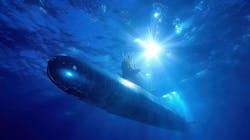Navy asks Lockheed Martin to provide counter-mine and anti-torpedo AN/SQQ-89A(V)15 undersea warfare system
Summary points:
- Lockheed Martin will support development, integration, and production of the AN/SQQ-89A(V)15 anti-submarine warfare system for U.S. Navy surface ships.
- The AN/SQQ-89A(V)15 enables surface ships to detect, track, and counter submarines, mines, and torpedoes using integrated sonar systems, torpedo detection, and real-time tactical data distribution.
- The system features a Linux-based open-systems architecture with POSIX compliance, VNC-enabled display reconfiguration, and planned enhancements for sonar processing, torpedo detection, and operator training.
WASHINGTON – Undersea warfare experts at the Lockheed Martin Corp. Rotary and Mission Systems segment in Manassas, Va., will support the U.S. Navy AN/SQQ-89A(V)15 anti-submarine warfare (ASW) systems for surface warships under terms of a $78.5 million order announced in late June.
Officials of the Naval Sea Systems Command in Washington are asking Lockheed Martin for Hypervisor Technology Zero Surface Ship Undersea Warfare combat systems and spares, engineering labor, program management, and engineering other direct costs, travel, and material in support of AN/SQQ-89A(V)15 combat system development, integration, manufacturing, production, and testing.
The AN/SQQ-89A(V)15 undersea combat system for surface warships is designed to search for, detect, classify, localize, and track underwater contacts; and to attack or avoid enemy submarines, floating, tethered, or bottom-attached mines, and torpedoes.
The AN/SQQ-89A(V)15 uses active and passive sonar to enable Navy Arleigh Burke-class destroyers and Ticonderoga-class cruisers to detect, locate, track, and attack hostile submarines, mines, and torpedoes.
Anti-torpedo warfare
The counter-mine and anti-torpedo system provides multi-sensor track correlation and target track management control, and forwards data to the ship’s weapons and decision-support systems. The AN/SQQ-89A(V)15 works together with the ship's active and passive hull sonar, multi-function towed array, sonobuoy processing, torpedo alerts, fire-control system, sensor performance predictions, embedded operator, and team training systems.
The AN/SQQ-89A(V)15 has an open electronics architecture to accommodate system upgrades, and makes the most of data accessibility and system modules, Lockheed Martin officials say. Its software application programs are isolated from hardware with open middleware to render applications processor-independent.
The system uses POSIX-compliant system calls and Motif and X-compliant display service calls. Symmetric multi-processors (SMPs) using Linux-based processing handle signal, data, display, and interface processing.
Virtual Network Computing (VNC) enables rapid re-allocation of operator console displays to suit the tactical situation, Lockheed Martin officials say.
Tell me more about the AN/SQQ-89A(V)15 undersea warfare system
- The AN/SQQ-89A(V)15 integrated undersea warfare combat system detects, classifies, tracks, and engages enemy submarines, mines, and torpedoes from Navy surface warships like Arleigh Burke-class destroyers and Ticonderoga-class cruisers. It combines hull-mounted sonar, towed sonar arrays, and sonobuoy processing to provide an acoustic picture. The system uses commercial-grade hardware and software, uses an open-systems architecture, and integrates countermeasures against incoming torpedoes.
Recent and planned upgrades to the AN/SQQ-89A(V)15 include improved automated torpedo detection, sonar performance prediction, advanced active sonar processing, re-designed active displays to reduce operator loading, and integrated training and logistics.
The AN/SQQ-89 is integrated with the Aegis combat system, vertical launch anti-submarine rocket (ASROC) system. A variant of the AN/SQQ-89A(V)15 is integrated with late-version Aegis combat systems being installed onboard new Arleigh Burke-class destroyers. A back-fit program is in place to retrofit existing DDG-51 class ships and Ticonderoga-class cruisers.
On this contract Lockheed Martin will do the work in Syracuse and Owego, N.Y.; Manassas, Va.; Lemont Furnace, Pa.; and Clearwater, Fla., should be finished by January 2029. With options, the contract could extend through January 2033.
For more information contact Lockheed Martin Rotary and Mission Systems online at www.lockheedmartin.com/en-us/who-we-are/business-areas/rotary-and-mission-systems.html, or Naval Sea Systems Command at www.navsea.navy.mil.
About the Author
John Keller
Editor-in-Chief
John Keller is the Editor-in-Chief, Military & Aerospace Electronics Magazine--provides extensive coverage and analysis of enabling electronics and optoelectronic technologies in military, space and commercial aviation applications. John has been a member of the Military & Aerospace Electronics staff since 1989 and chief editor since 1995.
